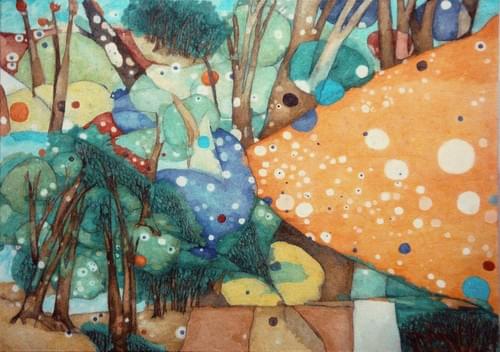
我腦海中的片影18 限量數位典藏版 No.1~15 / 15
NT$1,600
那些幽微、難以言喻的時刻,
如水面下閃爍的片影,偶爾浮現,轉瞬即逝。
《我腦海中的片影18》是藝術家 Kuo Yu HSU 對記憶感知的凝視,
以筆觸描繪內在情緒與感知邊界的流動時刻。
本作品首度釋出數位典藏版本,限量15張,
附藝術圖卡與正式授權書,邀您收藏一幅屬於心靈深處的風景。
💾 商品內容:
高解析數位圖檔(JPG,300dpi)
授權列印最大可列印尺寸為約 20.6 x 14.5(約A5)
附藝術圖卡一張(作品介紹+限量編號)
附數位授權書(含限量編號與藝術家簽名)
限量15份。每份皆附限量編號(如 KHSU-MB18-01/15),永久授權單次列印收藏。
建議採用5760dpi高解析度,250g/m²以上的彩色相片紙列印,高品質彩色印表機列印,即可呈現最佳細節層次。
切勿使用一般的彩色影印,效果極差。
向左滑動即可查看它的數位簽名
🔖 收藏這件作品,適合你如果:
你重視內在感受與藝術的私密對話
喜歡收藏限量且具有藝術家認證的數位作品
想在自己的空間中留一處靜謐的藝術之境
下單成功後會看到下載鏈接(鏈接有效期 72 小時),同時會收到一封附加下載鏈接的確認郵件。
下載完成後,我們將以電子郵件寄送藝術圖卡與授權書。
《我腦海中的片影18》
創作理念
記憶並非一條清晰、筆直的線,而是閃爍跳躍的光點,是某種濕潤而含糊的存在。在創作《我腦海中的片影18》時,我試圖捕捉這種「片影」——那些不完整卻深刻的感受,那些在腦海深處反覆浮現卻無法完全言說的影像。
「片影」這個詞,是我對這系列作品的核心命名。它不是完整的影像,不是劇情式的敘述,而是潛意識中閃現的瞬間。這些片段來自真實記憶,也來自夢境、感覺,或在創作過程中與畫布對話的結果。在創作第18號時,我感覺自己正處在一種記憶的沉澱層裡:那裡既有現實中經歷過的風景,也有從未發生卻似曾相識的情感回聲。
畫面中保留了模糊與留白的空間,並非技巧上的粗糙,而是一種對「未完成感」的尊重。這些未被填滿的區域,像是記憶中遺失的段落;它們可能會被重新解讀、重新連結,成為觀看者自身經驗的一部分。每一位觀者的凝視,都可能讓這幅畫延伸出新的敘述。
《我腦海中的片影18》在構圖上,採取較為靜謐的平衡關係,試圖以低彩度與柔和的筆觸營造出心理層面的景觀。我並未具象地描繪某處實景,而是透過形體與色塊的疊加,營造一種既熟悉又陌生的空間感。某些筆觸看似植物、看似窗景、看似遠山,卻始終停留在邊界,不讓它們變得清晰或可辨。這正是記憶片影的本質:它們模糊,它們流動,它們讓你無法確定自己究竟記得什麼。
在這幅畫中,我也特意保留了時間感的不確定性。畫面中既有筆觸的停頓,也有顏料流動的痕跡。時間不是線性的,而是一種沉澱與浮現交替的過程。某種程度上,這也是我對個人歷程的反思:創作不只是面對畫布,更是面對自身意識的來回波動。
《片影18》是此系列中較為內斂的一件作品,它不大聲說話,也不急於表現什麼。它的存在像一種靜靜潛伏的聲音,等待觀者的靠近與理解。這樣的作品,也許不會立即讓人驚豔,但它能留下某種餘韻,像在腦中停留的一個氣味、一道光、一聲細語。
這件作品不只是一個視覺物件,它是一種記憶與意識之間的對話場域。當我完成這幅畫時,我知道它記錄的不只是某一瞬間的情感,而是一段與自身內在經驗糾纏的歷程。也因此,我希望這幅畫不只是被觀看,更是被「感覺」與「召喚」——召喚每個人自身的片影,那些深藏而溫柔的、難以言說卻無法忘記的風景。
A Fragment in My Mind No.18
Artist Statement
Memory is not a clear, linear path—it is flickering, scattered light; something moist and elusive. In A Fragment in My Mind No.18, I sought to capture that very quality: the fragments of feelings, the half-formed images that resurface from the depths of consciousness, vivid yet impossible to fully articulate.
The word “fragment” is central to this series. These are not complete images, not narrative-based depictions, but moments that flash through the subconscious—memories, dreams, sensations, or even visual echoes arising in dialogue with the canvas. While creating No.18, I felt immersed in a sedimentary layer of memory—where real landscapes mixed with imagined ones, where emotions lingered like traces of light at the edge of wakefulness.
The painting deliberately preserves areas of ambiguity and emptiness—not as technical roughness, but as an act of honoring the sense of “incompletion.” These blank or hazy zones stand for the missing paragraphs of memory; they are open to reinterpretation, reattachment, and personal resonance. Each viewer brings their own experience, and in doing so, the painting lives anew.
In terms of composition, No.18 leans toward visual stillness and balance. Using low-saturation colors and soft, layered brushwork, I aimed to build a psychological landscape, rather than depict a specific scene. Certain forms suggest plants, windows, or distant hills—but they remain intentionally indistinct, always hovering at the threshold of recognition. That ambiguity is key: memory fragments don’t declare themselves clearly—they drift, they resist certainty, they ask to be felt rather than known.
I also wanted to suspend the sense of time in this work. There are pauses in the brushwork, flows in the pigment—traces of movement and stillness interwoven. Time is not linear here; it’s a process of sinking and resurfacing, a rhythmic presence. In a way, this reflects my own inner rhythm as an artist: painting becomes a dialogue not just with the canvas, but with shifting waves of awareness within myself.
No.18 is one of the more introspective pieces in this series. It doesn’t shout; it doesn’t seek to impress. Instead, it quietly waits—for attention, for a moment of connection. Perhaps it won’t dazzle at first glance, but like a lingering scent or a faint whisper, it stays with you, slowly revealing its texture over time.
This painting is not only a visual object, but a space for dialogue—between memory and presence, between artist and viewer. When I completed it, I knew I had documented more than just a moment of feeling; I had marked a journey into my own layered inner landscapes. And so, I hope this painting won’t just be looked at, but felt—and perhaps even awaken your own fragments, those gentle and unspeakable landscapes that reside within.




